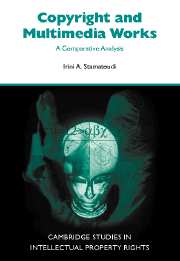Book contents
- Frontmatter
- Contents
- Acknowledgments
- List of abbreviations
- Introduction
- 1 Placing multimedia products within the scope of copyright
- 2 The scope of multimedia works
- 3 Traditional literary works
- 4 Collections and compilations
- 5 Databases
- 6 Audiovisual works
- 7 Computer programs
- 8 Video games as a test case
- 9 Multimedia products and existing categories of copyright works
- 10 A regime of protection for multimedia products
- 11 Conclusions
- Postscript
- Bibliography
- Index
10 - A regime of protection for multimedia products
Published online by Cambridge University Press: 25 July 2009
- Frontmatter
- Contents
- Acknowledgments
- List of abbreviations
- Introduction
- 1 Placing multimedia products within the scope of copyright
- 2 The scope of multimedia works
- 3 Traditional literary works
- 4 Collections and compilations
- 5 Databases
- 6 Audiovisual works
- 7 Computer programs
- 8 Video games as a test case
- 9 Multimedia products and existing categories of copyright works
- 10 A regime of protection for multimedia products
- 11 Conclusions
- Postscript
- Bibliography
- Index
Summary
A COPYRIGHT REGIME FOR MULTIMEDIA PRODUCTS
No existing copyright regime can perfectly accommodate multimedia products. Yet there is no doubt that most multimedia products constitute creations which are original and therefore merit copyright protection. In this chapter we will discuss the configurations of a specially tailored copyright protection for multimedia works, which, as will be shown, should be an amalgamation of the regime of protection for audiovisual works and that for databases.
In order for a work to qualify for copyright protection under UK copyright law, it has first to come within a category of protected works. For that purpose, and given the fact that no current category of copyrightable material is capable of accommodating all forms of multimedia products, a separate category for multimedia works should be introduced. In this category multimedia works should be defined as works which combine (on a single medium) more than one different kind of expression in an integrated digital format, and which allow their users to manipulate their contents with a substantial degree of interactivity. The essential features of the second generation of multimedia products are the combination of various kinds of expressions on a single medium to a larger extent than ever before, the predominantly integrated and merged format of the works once they have been incorporated in the multimedia product, as well as the fact that the degree of interactivity that they offer to users is well above any primitive form of interactivity.
- Type
- Chapter
- Information
- Copyright and Multimedia ProductsA Comparative Analysis, pp. 211 - 269Publisher: Cambridge University PressPrint publication year: 2001



